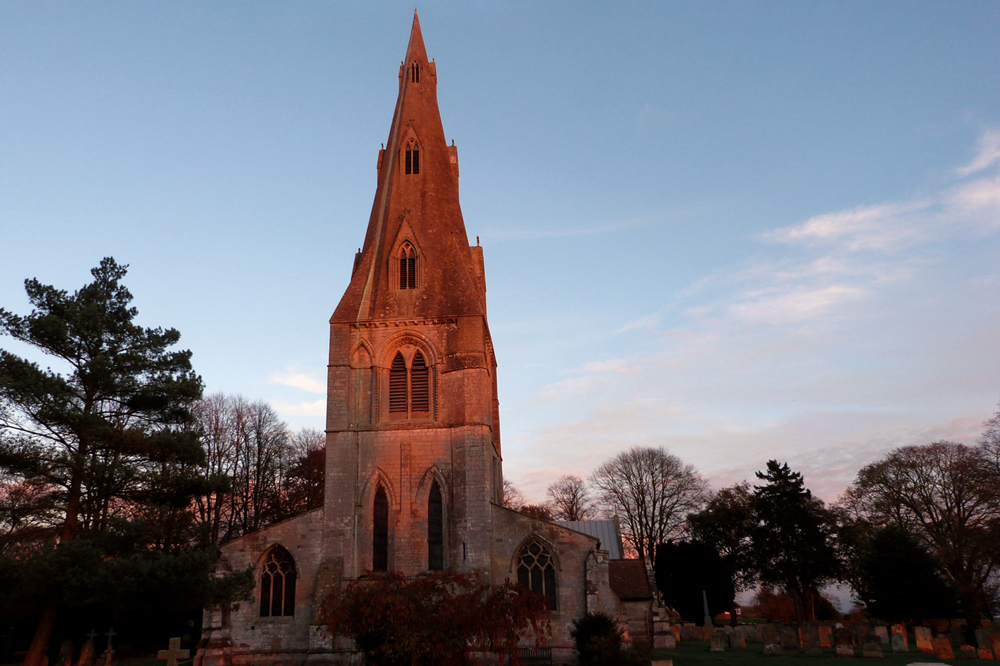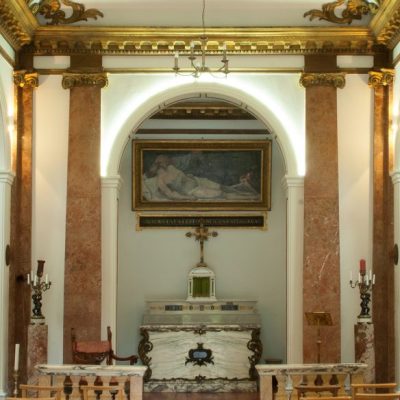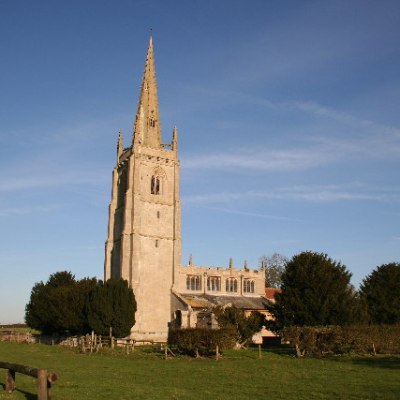While you have to fight your way through crowds in Cambridge to see the gothic splendour of King’s College Chapel, in the countryside around the city you will most likely find the parish churches that served Cambridgeshire’s medieval villages deserted. But – to take one example – the Assumption of the Blessed Virgin Mary at Harlton, a few miles to the south-west of Cambridge, has an imposing east chancel wall of huge niches with dizzying gothic canopies flanking the original reredos, sculpted from local clunch limestone in the late 14th century. The reredos was only repopulated with figures in the 1920s, but you only need to travel to the next village to find figural sculpture of medieval date: the beautiful crucifixion in the church of St Andrew, Orwell, dates from around 1300; broken no doubt in the Edwardian Reformation of the 1540s and discovered during Victorian restoration, it still shows signs of paint on the living cross and Christ’s wounds from his scourging. There is a medieval church in nearly every village in Cambridgeshire with similar treasures. And the pattern rarely varies across England.
There are around 16,000 churches in the care of the Church of England. Around 12,500 of these are listed, and around 8,000 of these are largely medieval structures. It’s easy to be complacent about them, with the common conception of the Church of England as immensely wealthy. This is not entirely incorrect: the Church of England maintains an £8.2 billion investment portfolio, which generates an annual return of 9.4 per cent. The Church spends around half of this and reinvests the rest, which guarantees its fiscal solvency. The largest single expenditure is on clergy pensions, and while some money goes towards cathedral maintenance, the rest is on general administration and wages. In effect, the Church spends next to nothing on maintaining parish buildings.
The east chancel wall, featuring a limestone reredos from the late 14th century, of the Parish Church of the Assumption of the Blessed Virgin Mary at Harlton, Cambridgeshire. Photo: © the author
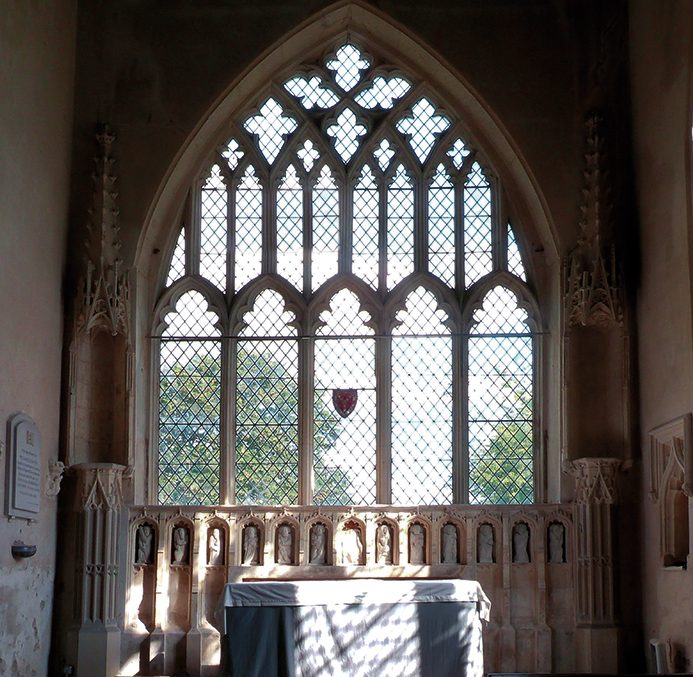
Not only does the Church of England not help pay for the upkeep of its parish churches, but congregations are expected to pay the Church for the services of its priests: a bespoke calculated payment known as a ‘parish share’. Church maintenance, except in extreme circumstances, comes in the form of hard-won grants, mostly from the National Churches Trust and the Heritage Fund (until recently, the Heritage Lottery Fund), which are matched by fundraising. Local people are forced to care and pay for the upkeep of their historic church. This includes the burden of lead theft, which is driven particularly by the rising price on the international market for raw metal, particularly for use in batteries, and carried out by organised gangs.
While this seems an appalling state of affairs, it is essentially the way it has always been. The duty of the Church authorities is to provide a priest for pastoral care, not a building. The architectural splendour of churches was originally provided by the communities they served. However, this does not mean that these communities owned their churches in any legal sense. Munificence to church fabric was, and still is, a donation: even if you took sole burden for a new nave aisle or personal chapel, it became the property of the Church. Because the supreme governor of the Church of England is the monarch, ultimate custody of parish churches is intrinsically meshed with the state. This is at least one positive aspect of an established church: it means that historic parish churches are held as public property for the common good, rather than individual advantage.
At least since the end of the Second World War, there has been significant concern over the survival of historic churches. Even without the decline of faith, the change of settlement patterns since the Industrial Revolution, if not earlier, has left rural England with a huge surplus of great church buildings. Fortunately, quasi-public status has meant that the parish church has not been destroyed to anything like the extent that the English country house has. Church demolitions in the 1950s and ’60s, which included some medieval buildings such as St Peter the Less, Chichester, and St Mary Bishophill Senior, York, were slowed down by the founding of the Redundant Churches Fund in 1969, now the Churches Conservation Trust. But transferring responsibility to the CCT is an option for a relatively small number of redundant churches. Although the burden of a parish share is removed, churches still depend on local support, usually in the form of a ‘Friends of’ charity or a local business looking after the key. With local generosity of time and effort, a church can be left locked and generally inaccessible. Lack of oversight means that CCT churches are particularly vulnerable, suffering high-profile thefts such as the painted rood-screen panels stolen from Torbryan in Devon in 2013, now recovered, and the panel of stained glass missing since 2016 from Withcote chapel, Leicestershire, which likely was made by the king’s glazier Galeon Hone in the 1530s.
Disestablishing the Church of England and vesting all of its historic property in English Heritage is neither foreseeable nor remotely practical. However, there needs to be a drastic change in the Church of England’s attitude towards historic buildings. Without the presence of its ancient steeples, with its adherents only meeting in utilitarian sheds, could the Church maintain any relevance at all? It ought to become a champion of its parish churches, supporting them as part of its mission, and lobbying for more public funding, as well as making more of its finances available for building upkeep.
To begin with, the Church needs to make it easier for communities to manage their buildings. Now that many former rural parishes are united into single team ministries, rotating services around each of the churches, a single Parochial Church Council of volunteers (with the parish priest as an important member) is stretched to the custodianship of as many as half a dozen buildings, and the burden of proper oversight becomes exceptionally onerous. Building administration should be kept apart from pastoral matters.
Limestone sculpture of the Crucifixion, dating from c. 1300 at the Parish Church of St Andrew, Orwell. Photo: © the author
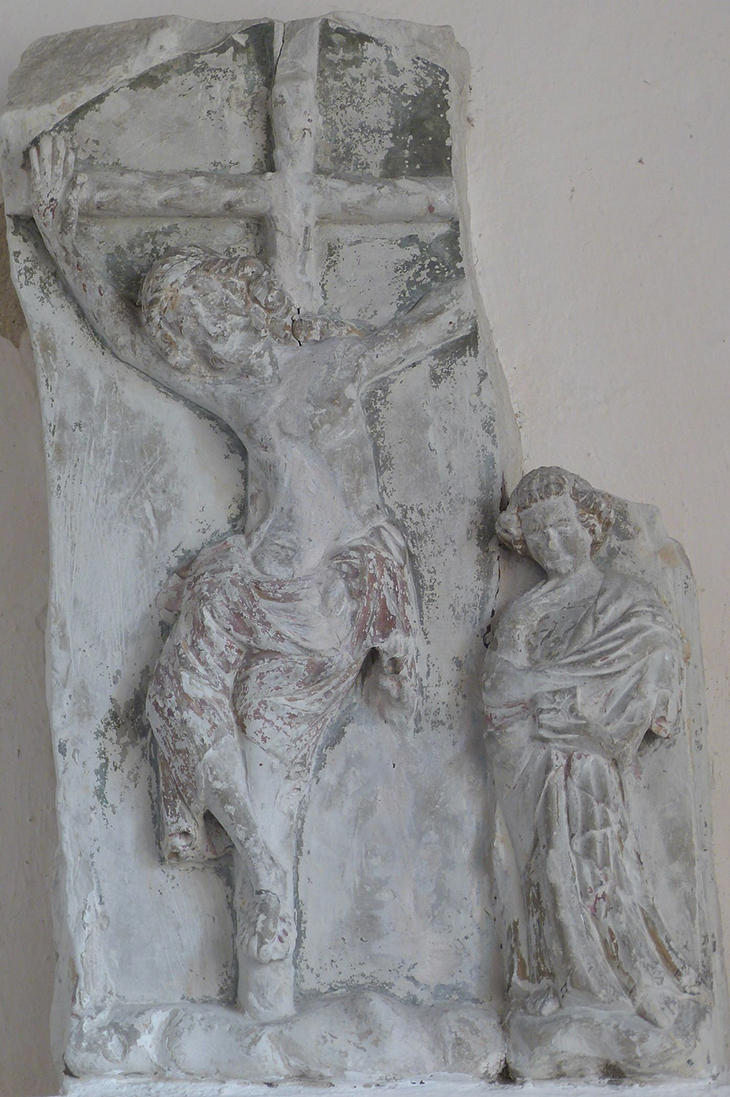
Increasingly, churches are called on to make their interiors more functional to serve their communities. Indoor toilets and kitchenettes are indeed important practical facilities that greatly enhance how the building can function; but while tearing out all the pews and replacing them with carpeting and plush chairs may increase cosy domesticity in the short term, it removes their sacred character (and the new stuff wears out quickly compared to stone or tiled floors and wooden benches). A misconception that medieval naves were pewless meeting-places is often exploited to justify this kind of aggressive secularisation, but countered by many surviving medieval nave benches in Devon and Suffolk, and documentation of installing nave seating is common as far back as the 13th century. Some pewings, such as that removed during the ongoing renovations at Bath Abbey, do restrict accessibility, but long benches are often the most flexible and practical system of seating. To take a strictly utilitarian approach, with every bit of space in a building being used through the insertion of office pods or a mezzanine floor, robs us of the uniquely sacred space a church represents. The medieval nave had its secular functions, but was still governed by strict canon law – so that, for example, if any blood was spilt in violence, the bishop had to reconsecrate the whole church.
The fact that buildings are vested in the Church helps protect them from private self-interest and opportunistic profiteering. All Anglican churches are protected by the faculty system, which among other things means that any modification to the building or its contents has to be approved by the diocese. The Church of England’s focus on mission above all means that improvements for contemporary worship – particularly of the Evangelical charismatic tradition, as at Holy Trinity Brompton – are given precedence over historic character and regular public access. Yet an open door to an impressive or peaceful historic building is, for most people, far more enticing than a band performing secular modern music.
The Church of England must do more to promote the idea that churches should be accessible for all outside hours of worship. Encouraging footfall increases security and is actually recommended by the leading church insurance company Ecclesiastical. Visitor donations are paltry, and maintaining a wall safe against petty theft can cancel them out, but technical solutions, such as using card and text-message payment, are within reach. In many rural areas – notably North Yorkshire, Devon, Cumbria and Northumberland – you will find church after church open for visiting. However, there are black spots, such as east Cheshire and around Kettering in Northamptonshire, where impressive village churches are kept firmly locked, with custodians reluctant to let anyone gain access except for services. Such hostility to public access to church buildings should be completely unacceptable. But in order to eliminate it, parish churches should have to bear as little burden in their administration as possible, and be given financial support rather than debts. The Church of England needs to start paying a little back to the generous legacy of buildings that made it what it is.
From the December 2019 issue of Apollo. Preview and subscribe here.
